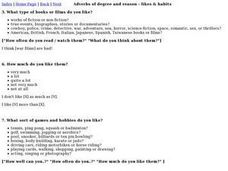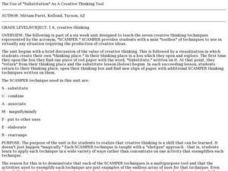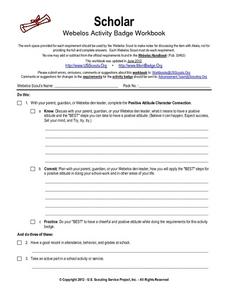Curated OER
Problem-Solving Strategy: Use Logical Reasoning homework 3.3
In this using logical reasoning to solve word problems worksheet, students use the logical reasoning problem solving strategy of drawing a table to solve word problems. Students solve two problems.
Curated OER
Best lesson in the whole world!
Students study the concept of fraction using mathematical reasoning. In this problem solving fraction lesson, students use various methods to explain their reasoning in solving fractions. Students use a number of different prompts to...
Curated OER
Students as "Grammarians": Discovering Grammatical Rules, Lesson on Reduced Clauses of Reason
In this grammar learning exercise, students work in pairs to complete the 24 reduced clauses of reason questions. In some questions, students write answers to specific questions, and in some they fill in blanks in sentences.
Curated OER
ESL Adverbs of Degree and Reason- Likes and Habits
In this ESL adverbs of degree and reason worksheet, students answer questions about books and films they like using the given format. They tell how much they like them by using comparisons. They describe the games and hobbies, and sort...
Curated OER
Problem-Solving Application: Choosing Reasonable Answers
In this reasonable answers worksheet, 1st graders apply their knowledge of how to select the most reasonable answer regarding the appropriate tool to use for measurement of different objects. There are 4 problems to solve.
Curated OER
The Use of Substitution As a Creative Thinking Tool
Students practice using substitution as a creative way of thinking about writing and try to substitute song lyrics, food items, rhythm movements and more. In this substitution lesson plan, students create a new candy, and create...
Curated OER
Probability and Statistics
Learners reason mathematically as they solve problems dealing with probability of an even occurring. In this probability lesson, students differentiate between different rankings of candidates running for leadership. They identify...
Curated OER
Number and Operations- Using Gift Certificates
Students apply number and operation skills to learn how to spend a gift certificate. In this mathematical reasoning lesson, students use base 10 blocks as money and calculate how much money they have.
Curated OER
This Man's Father
In this online instructional activity, students solve 1 creative thinking problem, where they determine who a man's father is given specific information. A solution is available.
Curated OER
ESL/ELL Reading and Reasoning Worksheet- Family Vacation
In this ESL/ELL reading and reasoning worksheet, students read a short selection about a family vacation. They answer 5 true or false questions before writing a short essay about how the family can solve the problem about how they spend...
Curated OER
Scholar/ Webelos Activity Book
In this psychology worksheet, students answer 13 questions that are focused upon measuring the attitude of positive thinking and its influence upon learning.
Curated OER
The Brain Teaser Five Pack
In this critical thinking worksheet, students explain in their own words the answers to 5 mentally challenging brain teasers asked on the worksheet.
Education Bureau of Hong Kong
Evaluating Casual Claims
Responsible decision making relies on the ability to a recognize, analyze, and evaluate claims. The worksheets and activities in this 32-page packet teach learners how to distinguish among opinions, reasoned arguments, facts, and logical...
Noyce Foundation
Photographs
Scaling needs to be picture perfect. Pupils use proportional reasoning to find the missing dimension of a photo. Class members determine the sizes of paper needed for two configurations of pictures in the short assessment task.
Mathematics Assessment Project
Modeling Motion: Rolling Cups
Connect the size of a rolling cup to the size of circle it makes. Pupils view videos of cups of different sizes rolling in a circle. Using the videos and additional data, they attempt to determine a relationship between cup...
EngageNY
Mid-Module Assessment Task: Grade 7 Mathematics Module 4
Assess the ability of the class to solve percent problems with an assessment that covers a variety of percent problems from basic to multi-step. Pupils make connections between percent problems and proportional thinking to complete...
Association of American Geographers
Project GeoSTART
Investigate the fascinating, yet terrifying phenomenon of hurricanes from the safety of your classroom using this earth science unit. Focusing on developing young scientists' spacial thinking skills, these lessons engage...
The New York Times
I Don’t Think So: Writing Effective Counterarguments
When it comes to writing effective arguments, writers must do more than simply make a claim, counterarguments must be considered. Aspiring writers analyze counterarguments in editorials, and then learn how to write counterarguments in...
Curated OER
A Glimmer of Beauty: Lesson Plan
Fully analyze the elements of art and unexpected beauty in the William Merritt Chase's Still Life with a Fish. The class will examine the painting very closely, then use photography to express unexpected beauty in still life. This is a...
Missouri Department of Elementary
I’m Thumbody!
Positive and negative thinking is the focus of a instructional activity that boost self-awareness. Beginning with a whole-class discussion, scholars brainstorm what positive thinking looks and sounds like then compares and contrast the...
Curated OER
Section 1: Analogies
Introduce your freshmen to analogies with this packet of prompts that also includes strategies for solving these critical thinking puzzles.
Noyce Foundation
Perfect Pair
What makes number pairs perfect? The resource provides five problems regarding perfect pairs of numbers, the definition of which changes in complexity with each task. Solutions require pupils to apply number sense and operations, as well...
Noyce Foundation
Diminishing Return
Challenge individuals to compete as many tasks as possible. Lower-level tasks have pupils apply costs and rates to solve problems. Upper-level tasks add algebraic reasoning and conditional probability to the tasks.
EngageNY
Tax, Commissions, Fees, and Other Real-World Percent Problems
Pupils work several real-world problems that use percents in the 11th portion of a 20-part series. The problems contain percents involved with taxes, commissions, discounts, tips, fees, and interest. Scholars use the equations formed for...

























